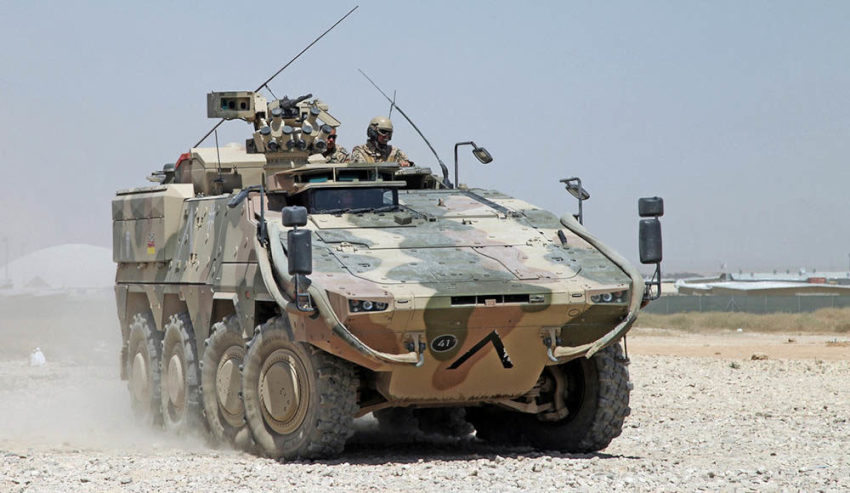With the LAND 400 Phase 2 decision rapidly approaching, Rheinmetall managing director Gary Stewart has taken Defence Connect through the decision to partner with Queensland in its bid to secure the $5 billion project.
Speaking to the Defence Connect Podcast, Stewart said the company came into the process with a "clean slate", having no exisiting factories or facilities in Australia.
"When the industry policy came out and really emphasised or underlined that having an enduring industrial footprint in Australia is also important, in addition to the defence capability, we said, 'Right, well, we don't have a home yet'," Stewart explained.
"It had already got politicised around which state could do the work and at the time, it was more of an Adelaide versus Melbourne debate or South Australia versus Victoria, and we didn't want to get caught into a political maelstrom, so we went to all the states and said, 'We are looking to establish a Military Vehicle Centre of Excellence that will first and foremost support the Australian customer and ensure that they continue to have the best capability that can be delivered, that will become a global design and manufacturing centre for Rheinmetall, for turrets and tactical systems'."
Five states approached the German defence giant with their proposals, and last year it was down-selected to two; Queensland and Victoria, the latter being the base chosen by Rheinmetall's LAND 400 Phase 2 competitor, BAE Systems Australia.
While much has been said of the state versus state mentality around securing lucrative defence projects, Stewart said the professionalism was to be admired.
"We went to all the states, and I've got to say all states and territories were very professional in how they approached it and we didn't mandate a location," he said.
"We said, 'These are the features that we're looking for. Access to resources, access to people, access to our defence customer, regional access for supporting the local region and the ability to attract and retain talent within that location'."
Stewart said the proposals from both states were "extraordinarily strong", but what pushed Queensland over the line rather than Victoria was multi-faceted; location, export and business opportunities with Singapore, design and manufacturing experience and the state's aerospace sector.
"We did down-select to Victoria and Queensland around this time last year and we looked at them, both of them, much more closely and on balance; we decided Queensland. And it wasn't just because of location, but we looked at things like, two of the three brigades that will be operating the LAND 400 vehicles are in Queensland. You then complement that with Singapore's investment into Queensland and there's going to be this concentration of military vehicles within Queensland that will need ongoing support, maintenance and upgrade," Stewart said.
"But we also recognised or discovered that, particularly south-east Queensland, actually has a very strong and well-established design and manufacturing for heavy vehicle, if you look at Volvo, if you look at Penske, you look at Caterpillar. They're already doing this class of vehicle for mining and other sectors. And then you overlay on top of that the strong land command, control, communications industry that's there; Raytheon, Harris, Elbit. Providing army's battle management system and communication, it's all done in Brisbane.
"And then if you look at the Brisbane-Ipswich corridor, with Amberley at one and Enoggera Barracks at the other, you've got a whole aerospace sector, with the likes of Boeing, Raytheon, Northrop-Grumman, that are directly supporting complex, digital equipment. Whilst it's for predominantly aircraft platform at the moment, if you look at the technology that's in a Boxer combat reconnaissance vehicle turret, it's closer to an aircraft that it is to an ASLAV or M113 that it's replacing."
And while Queensland would be set to benefit economically if Rheinmetall secures the project, Stewart has a resounding message for the rest of Australia.
"The investment and commitment we saw from the Queensland government, the delegation that they sent to Germany to understand our business and to understand what the potential was, beyond LAND 400 Phase 2, that we were looking to transfer and will transfer to Australia on being successful. They both have the manufacturing capacity and expertise. But the other thing, also, is that we're not abandoning Victoria. We're not abandoning South Australia," he said.
Rheinmetall's Boxer CRV is up against BAE Systems' Patria AMV-35, which would be built in Victoria. A decision on the project is expected in the coming weeks. The German company has partnered with several Australian SMEs for the project, including Melbourne's Heuch, Cablex and Tectonica Australia, Burnie-based Direct Edge, Brisbane-based G&O Kert, Melbourne/Brisbane-based Hilton Manufacturing, Perth-based Hoffman Engineering, Melbourne-based Nezkot Precision Tooling and Engineering, Adelaide-based Plasteel and Adelaide-based Redarc.
Rheinmetall has also committed to establishing a MILVEHCOE in Brisbane and will act as a sovereign industrial capability for the continuous design, manufacture, export and support for military vehicles, turrets and tactical systems.








